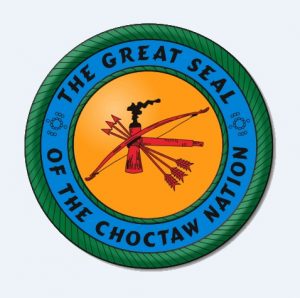The Choctaw Nation’s School of Choctaw Language is stepping up its ability to ensure the preservation of the Choctaw language thanks to a grant from the U.S. Department of Agriculture.
The school’s newest program, Holbvt toba Aianumpuli or Talking TV, is expected to get under way in early 2017 with a $449,384 budget to assist rural areas over the next three years. The total includes $263,384 from the USDA’s Distance Learning Telemedicine funding and $186,000 of matching funds from the Choctaw Nation.
“We are partnering with ten school systems to enhance the Choctaw language classes offered there,” said James Parrish, Executive Education Director of School Programs and Senior Director of the School of Choctaw Language for the Choctaw Nation. A variety of factors, including their rural setting, and significant need of equipment replacement, determined the selection of the sites chosen.
More than 700 students across Southeast Oklahoma via the Internet hear the broadcast of the Choctaw language classes. Sites receiving virtual instruction include 43 high schools, 14 Head Start facilities, and six community centers. Choctaw language also is taught in five colleges, two of them online.
School sites selected for the new Talking TV project are Antlers, Broken Bow, Caddo, Calera, Haileyville, Hugo, Idabel, Rock Creek, Valliant, Wright City. Also, plugging in for the enhanced programming are Choctaw Nation Community Centers in Atoka, Bethel, Coalgate, Smithville, Talihina, and Wright City. Also, the 14 Choctaw Nation Head Start/Child Care facilities participating are Antlers, Atoka, Bennington, Bethel, Broken Bow, Coalgate, Durant, Hugo, Idabel, McAlester, Poteau, Stigler, Wilburton, and Wright City.
J.T. Wallace, Technology Coordinator for the School of Choctaw Language, described one of the innovative, distance learning tools that will be improving the classroom experience at some of the locations.
“It’s called the EagleEye IV,” Wallace said. “It is a two-camera setup that can zoom in on the person talking. So, while one camera is for the whole class, the other is voice activated and will move in close up on the person in the group who is asking a question. It makes for a much more interactive class.”
The high-quality, two-way video conferencing cameras are much better. They will provide sharper images, thereby enabling clearer views and better communication between instructors and students.
In addition to the equipment upgrades, Parrish said, “We will be installing a Video/Archive Server so we can preserve our language and make it available for generations to come.” The server allows classrooms and students alike to review any past language tutorials at their convenience.
Choctaw language classes are not the only ones that will benefit from the improvements. When not in use by a Choctaw language class, the school may use the audio-visual equipment for other needs.
“It can be utilized for any community involvement, or even for teacher training,” Parrish said. “It’s a win-win situation.”
For additional information about the Holbvt toba Aianumpuli (Talking TV) program, contact the Choctaw Nation’s School of Choctaw Language, visit www.choctawschool.com or call 800-522-6170, Extension 2179.
***
About The Choctaw Nation
The Choctaw Nation is the third largest Indian Nation in the United States, with close to 200,000 tribal members. The first tribe over the Trail of Tears, the historical boundaries are in the southeast corner of Oklahoma. The vision of the Choctaw Nation is “To achieve healthy, successful, productive, and self-sufficient lifestyles for a proud nation of Choctaws.” Tribal business success over the past few years has enabled the Choctaw Nation to begin to achieve this vision, as well as to assist the communities that are in the Choctaw Nation. Faith, Family, and Culture are important values to Choctaw people. For more information about the Choctaw Nation, its culture, heritage, and traditions, please go to www.choctawnation.com.
Cutlines:
Photo by Charles Clark / Choctaw Nation.
James Parrish, Executive Education Director of School Programs and Senior Director of the School of Choctaw Language for the Choctaw Nation, left, and J.T. Wallace, Technology Coordinator for the School of Choctaw Language, discuss new equipment for the Choctaw language classes.
Photo by Charles Clark / Choctaw Nation
Colina Hickman, in her Durant office, prepares to instruct a Head Start class in the Choctaw language two hours away by using an Internet connection that allows her to interact with students in real time.








 EastTexasRadio.com Powered by Ten Stations
EastTexasRadio.com Powered by Ten Stations





